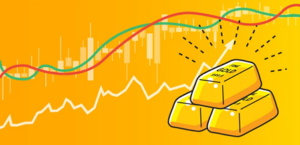Gold and silver have always been valued commodities. Is it worth considering them as a means of preserving and growing wealth today? Let’s debunk some popular myths.
One of the myths: Investing in precious metals is the most reliable option.
Investing in precious metals, such as gold and silver, is often considered a safe haven during uncertain times. While it is true that these metals generally hold their value and can act as a hedge against inflation, they are not without risks.
Precious metals have intrinsic value and are widely accepted as a store of wealth. They have a long history of being valued by individuals and societies across different cultures. During economic downturns or geopolitical instability, investors often turn to precious metals as a means of preserving their wealth.
However, it’s important to note that the prices of precious metals can be volatile. Factors such as supply and demand dynamics, economic indicators, and market sentiment can significantly impact their value. While they may provide stability and potential long-term growth, short-term fluctuations can occur, leading to potential losses if investments are not carefully timed.
Moreover, investing in precious metals may not generate income or dividends like other financial instruments. Their value primarily relies on capital appreciation, meaning you would need to sell them at a higher price than what you initially paid to realize a profit.
In summary, while investing in precious metals can be a part of a well-diversified investment portfolio, it should be approached with careful consideration. It can serve as a means of preserving wealth and acting as a hedge against inflation, but investors should be prepared for potential price volatility and the possibility of limited income generation.
When precious metals get cheaper, you have to buy them with all your money, because then they will rise in price anyway

Firstly, it’s important not to invest more than 10% of your investment portfolio in precious metals. Diversifying your investments is crucial, even if you’re considering gold or silver. Secondly, you need to determine your objective: whether you want to generate quick profits or preserve your savings. Your investment strategy will depend on this decision.
If you’re aiming for quick returns, financial experts suggest buying assets when their prices start to rise after a decline and selling when prices begin to decrease. However, successfully executing this strategy requires diligent market monitoring.
It’s worth noting that you’ll need to overcome your own psychological biases. When the price of your investment increases, there’s a natural inclination to lock in the profits. For example, if you bought a precious metal at $1,100 and sold it during a price increase at $1,300, but the price later rose by an additional $500.
On the other hand, if the price of your investment declines and you’re waiting for it to recover, selling at a loss can be psychologically challenging. Emotional fluctuations can lead to greater losses.
Additionally, frequent buying and selling should be avoided due to commission fees associated with each transaction. These fees can erode your profits. Therefore, it’s important to establish clear boundaries on how long you should wait to evaluate a trend.
If you lack experience in market trading, it’s generally better to invest for the long term, as this approach tends to yield higher returns. You could adopt a strategy where you regularly allocate a small portion of your disposable income to precious metals, regardless of their current price, such as every two weeks. Over several years, this tactic should prove beneficial as the value of precious metals typically outpaces inflation.

It is better to buy the most expensive metal, you can earn more on it
Not always. It depends on various factors such as market conditions, supply and demand dynamics, and the specific characteristics of the metal itself.
Gold and silver have long been considered valuable and have been used as a store of wealth throughout history. They have intrinsic value and are not tied to any particular currency or government. During times of economic uncertainty or inflation, they are often seen as safe-haven assets.
However, it’s important to note that the value of gold and silver can be subject to fluctuations and market volatility. Their prices can be influenced by factors such as economic indicators, geopolitical events, investor sentiment, and market speculation. It’s essential to carefully analyze these factors before considering them as a means of preserving and growing wealth.
Moreover, while gold and silver have shown resilience over the long term, they are not immune to market risks. Like any investment, there is always a potential for losses. It’s crucial to diversify your portfolio and not rely solely on precious metals for wealth preservation and growth.
Ultimately, whether gold and silver are suitable for preserving and multiplying money depends on an individual’s financial goals, risk tolerance, and the overall investment strategy. It’s advisable to consult with a financial advisor or conduct thorough research before making any investment decisions.
Another myth: Buying jewelry is also an investment in precious metals
No, purchasing jewelry is not a reliable way to invest in precious metals. The price of jewelry is often significantly higher than the intrinsic value of the metal it contains. When selling jewelry, buyers primarily consider the metal’s value and not the artistic craftsmanship or design. As a result, you are likely to recover only a fraction of your initial investment, usually around half or even less, unless you possess a rare or antique piece sought after by collectors.
In certain countries such as India or the United Arab Emirates, buying gold jewelry is regarded as an investment because they create jewelry with high gold purity and sell it with a minimal markup, typically around 10%. However, in most cases, jewelry elsewhere tends to have lower purity levels and higher markups, making it difficult to sell regular jewelry at a significant profit.
Therefore, if your aim is to invest in precious metals, it is generally more advisable to focus on acquiring bullion or coins with high metal purity and recognized market value. These forms of investment allow you to obtain the actual metal content without the additional costs associated with jewelry craftsmanship and design.




